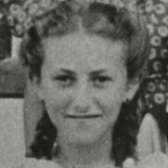
-
Learn More about Irene
- Collections View Irene’s family photographs
- First Person Watch Irene share her Holocaust experiences at a First Person program
- Oral History Access Irene's Oral Testimony
In an instant, the life of 13-year-old Irene Weiss changed forever when she and her sister, Serena, were assigned to a work detail, while many other family members were sent to their immediate deaths by a Nazi guard at Auschwitz-Birkenau. “We asked the other prisoners when we would see our families,” Irene remembers. “A woman pointed to the chimney and said, ‘Do you see the smoke? There is your family.’”
Biographical Information
Irene Weiss was born Iren Fogel on November 21, 1930, in Bótrágy, Czechoslovakia (now Batrad’, Ukraine) to Meyer and Leah Fogel. Meyer owned a lumber yard, and Leah managed their home and cared for Irene and her five siblings—Moshe, Edit, Reuven, Gershon, and Serena.
When Nazi Germany dismembered Czechoslovakia in late 1938, Bótrágy, located in Subcarpathian Rus, came under Hungarian rule. Hungarian authorities banned Jews from attending school, confiscated Jewish businesses, and required thousands of Jewish men to be inducted into Hungarian forced labor brigades under military command. Among them was Irene’s father, Meyer, who was conscripted in 1942.
Six months later, Meyer returned home, only to find life more restrictive and harsh for Hungarian Jews. In April 1944 Hungarian authorities rounded up tens of thousands of Hungarian Jews, including the Fogels, and crowded them into a ghetto in Munkács, a brick factory that was never intended to house people.
Hundreds of families were forced to live in overcrowded conditions. The only restroom was a latrine in the shape of a trench, which the inhabitants were made to dig outside. Shortly after their arrival, all girls under the age of 16 were forced to have their heads shaved. Irene’s mother gave her a scarf to wear around her bald head, which made Irene look older and probably helped save her life during a future selection at Auschwitz-Birkenau.
Over a two-month period beginning in May 1944, nearly 425,000 Jews were deported from Hungary to Auschwitz-Birkenau, including Irene and her family. Irene was 13 years old. Upon arrival at the camp, her mother, three younger siblings, and older brother were killed.
SS authorities selected Irene and her sister Serena for forced labor, while their father was forced to work as a prisoner in the Sonderkommando, removing corpses from the gas chambers and cremating them. The SS camp staff periodically killed the members of the Sonderkommando and replaced them with persons from newly arriving transports. While still in the camp, Irene’s aunt learned through a boy from their hometown that when Meyer could no longer perform this work, the SS shot and killed him.
Irene, Serena, and two maternal aunts, Rose and Piri Mermelstein, worked in the “Canada” section of Birkenau—storage warehouses located near two crematoria—for eight months until January 1945, when the SS forcibly evacuated them on foot to the Ravensbrück concentration camp in central Germany. Three weeks later, the SS transported them to Neustadt-Glewe, a subcamp of Ravensbrück, east of Hamburg. There Piri became ill and was killed.
One day during morning roll call, the SS separated Serena and other prisoners from the group, deeming them too weak and emaciated to work. Irene said to a camp guard, “She is my sister,” and was then allowed to go with Serena. The sisters heard from other inmates that they would be sent back to Ravensbrück, where there were gas chambers. They were locked in a room with other prisoners to await the transport truck, but it never arrived.
As Soviet troops approached, the SS personnel fled, leaving the camp unguarded, and the prisoners gradually left. Irene, Serena, and Rose found temporary shelter in an empty house in a nearby town. Soon after, the three women made their way to Prague to look for relatives or other survivors.
In Prague they found an uncle, Joseph Mermelstein, who in 1938 had emigrated from his hometown to Palestine and returned as a soldier in the Czech Legion of the British Army. A few aunts and uncles survived, but Irene and Serena were the only surviving children from the family.
Irene, Serena, and Rose lived together with their surviving relatives in Teplice-Šanov in the Sudetenland. Irene attended a Czech school, Serena worked in a factory, and Rose remained at home, ill with tuberculosis. With the sponsorship of relatives and financial aid from the Hebrew Immigrant Aid Society, Irene, Serena, and Rose immigrated to New York in 1947.
Irene married Martin Weiss in 1949 and they moved to northern Virginia in 1953. She earned a bachelor of arts degree in education from American University and taught in the Fairfax County Public School system in Virginia for 13 years. Irene and Martin have three children and Irene is a volunteer at the United States Holocaust Memorial Museum.



